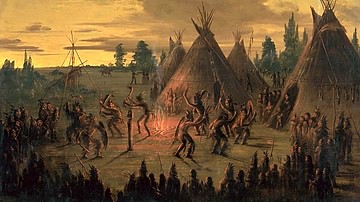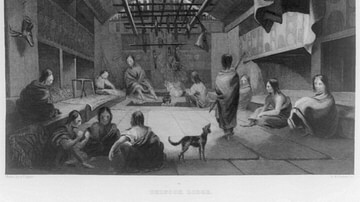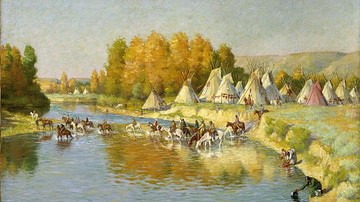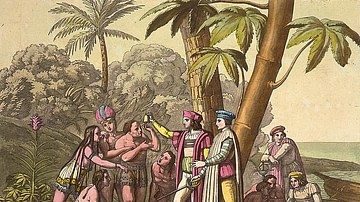The Raven tales are stories featuring the trickster figure Raven that come from the Athabaskan (Dene)-speaking peoples of the Pacific Northwest and other First Nations of the region of modern-day Canada. Raven, like the trickster figures of other Native peoples of North America, is depicted in these stories as a supernatural entity who may be a wise man or a fool.
According to the lore of some First Nations, Raven is the creator god who made all things as they are. Scholar Larry J. Zimmerman comments:
As a creator, Raven made the world twice over. The first world was a paradise: meat was plentiful, and rivers flowed in both directions, so people never had to paddle their canoes. But Raven thought this world too easy for humans, and so he remade it in its familiar form, with all its hardships and woes.
(190)
The Athabaskan (Dene)-speaking peoples – which include the Aleuts, Inuit, Haida, Tahltan, Tlingit, Tsimshian, among many others – recognize the spiritual power of Raven and include his image in iconography such as seen on the traditional 'totem pole' which is still crafted in keeping with the traditions of the people.
The legend Raven's Great Adventure features the main character as a playful trickster and also explains why the image of Raven on totem poles has no beak. Raven and His Grandmother presents the figure's more selfish and vindictive aspect.
As with the trickster figures of other nations – featured in the Glooscap tales of the Wabanaki Confederacy, Manabozho tales of the Ojibwe and other Algonquin peoples, Coyote tales of the Shasta nation, Saynday tales of the Kiowa, or any others – Raven is an unpredictable character who may bring good fortune or bad luck but, either way, stands as a symbol of transformation and offers an audience the opportunity to learn from his, often, bad behavior and change their own.
Text
The following is taken from Voices of the Winds: Native American Legends by Margot Edmonds and Ella Clark. The introduction to Raven's Great Adventure is given by them:
Raven's Great Adventure
Early North American Indians living along the Alaska and North Pacific coast carved the stories of their people on trees, as they had no written language.
They carved strange and beautiful figures, representing people, animals, birds, fish, and supernatural characters, then painted them with bright colors. The tallest red cedar trees were selected for totem poles and are used for landmarks as well as illustrating the legends told from generation to generation.
On one of these poles was carved a stunning Raven, but he had no beak!
The Raven in Alaska was no ordinary bird. He had remarkable powers and could change into whatever form he wished. He could change from a bird to a man, and could not only fly and walk, but could swim underwater as fast as any fish.
One day, Raven took the form of a little, bent-over old man to walk through a forest. He wore a long white beard and walked slowly. After a while, Raven felt hungry. As he thought about this, he came to the edge of the forest near a village on the beach. There, many people were fishing for halibut.
In a flash, Raven thought of a scheme. He dived into the sea and swam to the spot where the fishermen dangled their hooks. Raven gobbled their bait, swimming from one hook to another. Each time Raven stole bait, the fishermen felt a tug on their lines. When the lines were pulled in, there was neither fish nor bait.
But Raven worked his trick once too often. When Houskana, an expert fisherman, felt a tug, he jerked his line quickly, hooking something heavy. Raven's jaw had caught on the hook! While Houskana tugged on his line, Raven pulled in the opposite direction. Then Raven grabbed hold of some rocks at the bottom of the sea and called, "O rocks, please help me!" But the rocks paid no attention.
Because of his great pain, Raven said to his jaw, "Break off, O jaw, for I am too tired." His jaw obeyed, and it broke off.
Houskana pulled in his line immediately. On his hook was a man's jaw with a long white beard! It looked horrible enough to scare anyone. Houskana and the other fishermen were very frightened because they thought the jaw might belong to some evil spirit. They picked up their feet and ran as fast as they could to the chief's house.
Raven came out of the water and followed the fishermen. Though he was in great pain for lack of his jaw, no one noticed anything wrong because he covered the lower part of his face with his blanket.
The chief and the people examined the jaw that was hanging on the halibut hook. It was handed from one to another, and finally to Raven who said, "Oh, this is a wonder to behold!" as he threw back his blanket and replaced his jaw.
Raven performed his magic so quickly that no one had time to see what was happening. As soon as Raven's jaw was firmly in place again, he turned himself into a bird and flew out through the smoke hole of the chief's house. Only then did the people begin to realize it was the trickster Raven who had stolen their bait and been hooked on Houskana's fishing line.
On the totem pole, Raven was carved, not as the old man, but as himself without his beak, a reminder of how the old man lost his jaw.
Raven and His Grandmother
In her barrabara (a native home) at the end of a large village, lived an old grandmother with her grandson, a raven. The two lived apart from the other villagers because they were disliked. When the men returned from fishing for cod, the raven would come and beg for food, but they would never give him any of their catch. But when all had left the beach, the raven would come and pick up any leftover refuse, even sick fish. On these, raven and his grandmother lived.
One winter was extremely cold. Hunting was impossible; food became so scarce the villages neared starvation. Even their chief had but little left. So, the chief called all his people together and urged them to use every effort to obtain food enough for all, or they would starve.
The chief then announced that he wished for his son to take a bride and she would be selected from the girls of the village. All the girls responded to the excitement of the occasion and dressed in their very best costumes and jewelry.
For a short time, hunger was forgotten as the girls lined up for the contest and were judged by the critical eye of their chief, who selected the fairest of the fair for his son's bride. A feast was given by the chief following their marriage ceremony. But soon after hunger began again.
The raven perched on a pole outside his barrabara, observing and listening attentively to all that had happened. After the feast, he flew home and said to his grandmother, "I, too, want to marry." She made no reply, so he went about his work, gathering what food he could for his little home. Each day he flew to the beach and found dead fish or birds. He always gathered more than enough for two people. While he was in the village, he noted that the famine seemed worse. So, he asked the chief, "What will you give me, if I bring you food?"
The chief looked at him in great surprise and said, "You shall have my oldest daughter for your wife." Nothing could have pleased raven more. He flew away in a joyful mood and said to his grandmother, "Let's clean out the barrabara. Make everything clean for my bride. I am going to give the chief some food, and he has promised to give me his oldest daughter."
"Ai, Ai, Y-a-h! You are going to marry? Our barrabara is too small and too dirty. Where will you put your wife?"
"Caw! Caw! Caw! Never mind. Do as I say," he screamed at his grandmother, and began pecking her to hurry.
Early next morning raven flew away, and later in the day returned with a bundle of yukelah (dried salmon) in his talons. "Come with me to the chief's house, grandmother," he called to her. Raven handed the fish to the chief and received the chief's oldest daughter for his bride.
Raven preceded his grandmother as she brought the bride to their little home. He cleared out the barrabara of old straw and bedding When the two women arrived, they found the little home empty, and the grandmother began to scold him and said, "What are you doing? Why are you throwing out everything."
"I am cleaning house, as you can see," Raven curtly said.
When night came, raven spread wide one wing, and asked his bride to lie on it, and then covered her with the other wing. She spent a miserable night, as Raven's fish odor nearly smothered her. So she determined she would leave in the morning.
But by morning, she decided to stay and try to become accustomed to him. During the day she was cheerless and worried. When raven offered her food, she would not eat it. On the second night, raven invited her to lay her head on his chest and seek rest in his arms. Only after much persuasion did she comply with his wish. The second night was no better for her, so early the next morning she stole away from him and went back to her father's house, telling him everything.
Upon waking and finding his wife gone, Raven inquired of his grandmother what she knew of his wife's whereabouts. She assured raven that she knew nothing. "Go then to the chief and bring her back to me," called raven. Grandmother feared him and left to do his bidding. When she came to the chief's house, she was pushed out of the door. This she promptly reported to her grandson.
The summer passed warm and pleasant, but a hard winter and another famine followed. As in the previous winter, the grandmother and the raven had plenty of food and wood, while others suffered greatly from lack of food. Raven's thoughts again turned to marriage. This time she was a young and beautiful girl who lived at the other end of the village. He told his grandmother about her and that he wanted to marry her. He asked, "Grandmother, will you go and bring the girl here, and I will marry her."
"Ai, Ai, Y-a-h! And you are going to marry her? Your first wife could not live with you because you smell strong. The girls do not wish to marry you."
"Caw! Caw! Caw! Never mind my smell! Never mind my smell! Go–do as I say."
To impress his commands and secure her obedience, he started pecking at her until she was glad to go. While his grandmother was gone, raven became restless and anxious. He hopped about the barrabara and nearby hillocks, straining his eyes for a sight of his expected bride.
Hurriedly he began cleaning out the barrabara, throwing out old straw, bedding, baskets, and all. The grandmother upon her return scolded Raven, but he paid no attention to her.
The young bride, like her predecessor, was enfolded tightly in his wings, and likewise she had a wretched and sleepless night. But she was determined to endure his odor if possible. She thought at least with him she would have plenty of food to eat. The second night was as bad as the first, but she stayed on and secretly concluded she would do her best to stay until spring.
On the third day the raven, seeing that his wife was still with him, said, "Grandmother, tomorrow I will go and get a big, fat whale. While I am gone, make a belt and a pair of torbarsars (native shoes) for my wife."
"Ai, Ai, Y-a-h! How will you bring a big, fat whale? The hunters cannot kill one, how will you do it?"
"Caw! Caw! Caw! Be quiet and do what I tell you: make the belt and torbarsars while I go and get the whale," he angrily exclaimed, using his most effective method of silencing her.
Before dawn next morning the raven flew away to sea. In his absence, the old woman was busily engaged making the things for the young bride, who watched and talked to her. About midday, they saw Raven flying toward shore, carrying a whale.
The grandmother started a big fire, and the young woman tucked up her parka (native dress), belted it with her new belt, put on the new torbarsars, sharpened the stone knife, and went to the beach to meet her husband. As he drew near, he called, "Grandmother, go into the village and tell all the people that I have brought home a big, fat whale."
She ran as hard as she could and told the joyful news. The half- dead people suddenly became alive. Some sharpened their knives, others dressed in their best clothes. But most of them just ran as they were and with such knives as they had with them to the beach to see the whale.
His sudden importance was not lost on the raven, who hopped up and down the whale's back, viewing the scene of carnage, as the people gorged themselves on the whale.
Every few moments raven would take a pebble out of his bag, then after some thought put it back. When the chief and his relatives came near, Raven drove them away. They had to be content just watching the people enjoy their feasting and carrying off blubber to their homes. Later, in the village, the people did share with the chief.
The raven's first wife, the chief's daughter, had a son by him, a little raven. She had it in her arms at the beach and walked in front of raven, where he could notice her. "Here is your child, look at it," she called. But he ignored her. She called to him several times and continued to show him the baby. At last he said, "Come closer–nearer still." But when she could not stand his odor any longer, she left him without a word.
Death occurred as a result of the feast. Many of the people ate so much fat on the spot that they died soon after. The rest of the people had eaten so much and filled their barrabaras so full, that during the night they all suffocated. Of the entire village, only three were left–the raven, his new wife, and the grandmother. There they lived on as their descendants do to this day.







